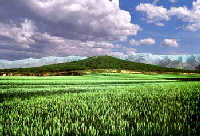|
The mausoleum above ground level
 |
| The Burial Mound of Qinshihuang's Tomb |
The mausoleum covers 56.25 square km - 78 times the area of the Forbidden City. However, the hill-like grave mound is the only remaining part of the above ground structure. Years of weathering and damage have reduced its total area from the original 250,000 sq m to 120,000 sq m. and its height from 115 m to 87 m.
Contemporary archeologists have reproduced on canvas some of the grandeur of the mausoleum based on the site's ruins. It was designed in accordance with the layout of the emperor's capital, Xianyang, 25 km northwest of Xi'an. The tomb was enclosed by two walls; an inner city wall and an outer city wall, forming the shape of the Chinese character hui (meaning to return). Some palaces and homes of workers in charge of gardens and temples are among the above ground structures discovered so far.
The emperor's underground palace
There are descriptions of the underground tomb and its layout in historical documents. The tomb was very deep and solid with a vermilion stone wall to block groundwater, making it waterproof. Inside the tomb were palaces and the burial places of all Emperor Qin's high officials. Treasures and jewels were stored there and whale-oil candles burned 24 hours a day. Booby traps such as hidden arrows protected the tomb from robbers and looters.
The underground palace where the emperor's burial chamber is located has long been a mystery and speculations as to the exact location abounded. Although it has yet to be fully excavated, results from remote sensing tests show what it was really like when it was built. The palace is 170m long and 145m wide and lies about 35 meters beneath the burial mound. It symbolizes the emperor's actual palace when he was alive.
The rectangular-shaped burial chamber of the emperor, situated in the middle of the palace, is about 15m high, 100-110m long and 64-75m wide - about the same size as a soccer field. Only two passageways have been discovered so far in the chamber, which is inconsistent with the usual four passageways leading in four directions in the tombs of other emperors over 2,000 years ago.
A thick and solid earth wall, about 168m long and 141m wide, encircles the burial chamber. During the construction of the wall, its hardness was constantly tested. A worker standing at a distance would shoot at the wall with an arrow. If the arrow could penetrate through the wall, it had to be rebuilt. On the inner side of the earth wall is a stone wall. These two walls were made to ensure the safety of the burial chamber. Despite several devastating earthquakes in this area over the past 2,000 years, there are no signs of collapse in the tomb. This incredible feat, according to experts, might be due to the protection of the solid surrounding wall.
The land where the Qin tomb was built slopes down from southeast to northwest Damage from ground water seepage was thwarted by a huge dam stretching over 1,000 m built inside the tomb to waterproof it. The dam is actually an 84 m wall, with a 17 m thick waterproof base. Interestingly, almost the same waterproofing technology was used in the construction of the National Grand Theatre of China in 2004.
A large quantity of mercury was used in artworks in the underground palace, as described in The Historical Records: "mercury was used to symbolize surging river, lakes, and the sea." The use of mercury in depictions of the netherworld conveys the emperor's ambition to rule the land forever. In addition, mercury is a highly poisonous metal that can kill robbers and prevent bodies and burial articles from decomposing.
|

